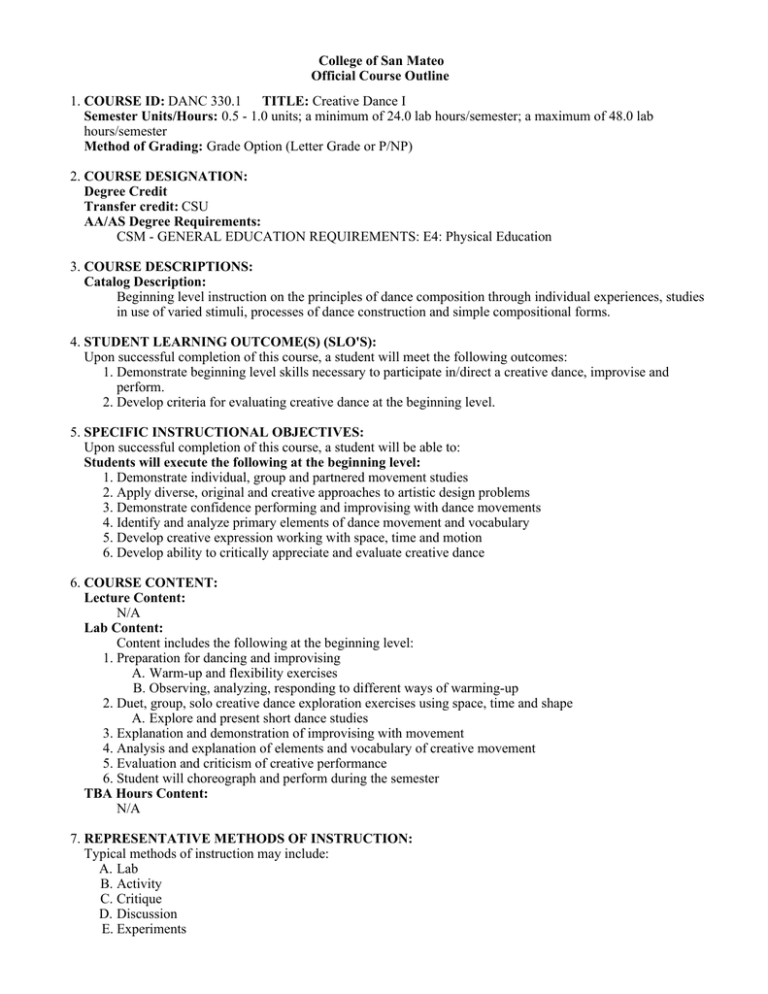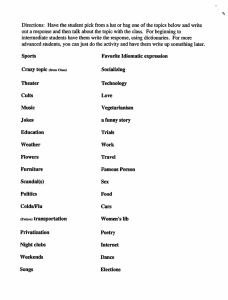College of San Mateo Official Course Outline COURSE ID: Semester Units/Hours:
advertisement

College of San Mateo Official Course Outline 1. COURSE ID: DANC 330.1 TITLE: Creative Dance I Semester Units/Hours: 0.5 - 1.0 units; a minimum of 24.0 lab hours/semester; a maximum of 48.0 lab hours/semester Method of Grading: Grade Option (Letter Grade or P/NP) 2. COURSE DESIGNATION: Degree Credit Transfer credit: CSU AA/AS Degree Requirements: CSM - GENERAL EDUCATION REQUIREMENTS: E4: Physical Education 3. COURSE DESCRIPTIONS: Catalog Description: Beginning level instruction on the principles of dance composition through individual experiences, studies in use of varied stimuli, processes of dance construction and simple compositional forms. 4. STUDENT LEARNING OUTCOME(S) (SLO'S): Upon successful completion of this course, a student will meet the following outcomes: 1. Demonstrate beginning level skills necessary to participate in/direct a creative dance, improvise and perform. 2. Develop criteria for evaluating creative dance at the beginning level. 5. SPECIFIC INSTRUCTIONAL OBJECTIVES: Upon successful completion of this course, a student will be able to: Students will execute the following at the beginning level: 1. Demonstrate individual, group and partnered movement studies 2. Apply diverse, original and creative approaches to artistic design problems 3. Demonstrate confidence performing and improvising with dance movements 4. Identify and analyze primary elements of dance movement and vocabulary 5. Develop creative expression working with space, time and motion 6. Develop ability to critically appreciate and evaluate creative dance 6. COURSE CONTENT: Lecture Content: N/A Lab Content: Content includes the following at the beginning level: 1. Preparation for dancing and improvising A. Warm-up and flexibility exercises B. Observing, analyzing, responding to different ways of warming-up 2. Duet, group, solo creative dance exploration exercises using space, time and shape A. Explore and present short dance studies 3. Explanation and demonstration of improvising with movement 4. Analysis and explanation of elements and vocabulary of creative movement 5. Evaluation and criticism of creative performance 6. Student will choreograph and perform during the semester TBA Hours Content: N/A 7. REPRESENTATIVE METHODS OF INSTRUCTION: Typical methods of instruction may include: A. Lab B. Activity C. Critique D. Discussion E. Experiments F. Individualized Instruction F. Individualized Instruction G. Observation and Demonstration 8. REPRESENTATIVE ASSIGNMENTS Representative assignments in this course may include, but are not limited to the following: Writing Assignments: A. Journals a. Critical analysis of work done in classroom assignments b. Explorations for future dance studies/presentations B. A written assignment describing students' intentions and concepts of their dance composition Reading Assignments: A. Instructor generated handouts Other Outside Assignments: A. Student presentations of solo, duet and group dance studies exploring space, motion and time B. Presentation of student choreographed work C. Final dance presentation 9. REPRESENTATIVE METHODS OF EVALUATION Representative methods of evaluation may include: A. Class Participation B. Class Performance C. Class Work D. Final Class Performance E. Final Performance F. Final Public Performance G. Group Projects H. Homework I. Lab Activities J. Portfolios K. Projects 10. REPRESENTATIVE TEXT(S): Possible textbooks include: A. Reeve, Justine. Dance Improvisations: Warm-Ups, Games and Choreographic Tasks, ed. Human Kinetics, 2011 Other: A. Possible selections may be instructor-generated handouts on dance vocabulary, technique, theory and history. Handouts may also include material about musical interpretation and dance as artistic / cultural expression. Origination Date: January 2013 Curriculum Committee Approval Date: November 2013 Effective Term: Fall 2014 Course Originator: Denaya Dailey



